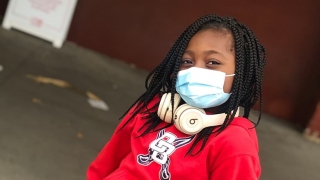Gene Therapy for Sickle Cell Disease
What is sickle cell disease?
Sickle cell disease is an inherited blood disorder caused by errors in the beta globin gene, which is part of hemoglobin, a protein found in red blood cells that carries oxygen to tissues throughout the body. The abnormal hemoglobin causes the red blood cells to become hard, pointed, sticky and shaped like crescents.
When these misshapen red cells go through the small blood vessels, they often get stuck and block the vessels. The blockage of blood flow through blood vessels causes severe, recurrent pain crises that lead to organ damage and shortened life span.
How is gene therapy used to treat sickle cell disease in children?
With gene therapy, patients have their own hematopoietic stem cells (primitive cells that can develop into any type of blood cell) collected from their blood. These blood stem cells are then edited using CRISPR technology to block the expression or function of a certain gene, leading to the reactivation of normal fetal hemoglobin. After the patient receives chemotherapy to eliminate the unchanged blood stem cells, the edited blood stem cells are returned to the patient.
Sickle cell disease treatment options at CHOP
CHOP is an approved site to begin offering one of the new therapies, called Lfygenia™, which is manufactured by bluebird bio and uses a cell-based gene therapy. CHOP also plans to offer the other product, called Casgevy™, which is manufactured by Vertex Pharmaceuticals and uses the Nobel Prize-winning CRISPR gene-editing technology.
For almost two decades, CHOP has been at the forefront in the treatment of sickle cell disease as well as multiple gene therapies to treat other rare and complex diseases. In the mid-2000s, research began on what would become Luxturna, the first FDA-approved gene therapy for a genetic disease, in this case an inherited retinal disease. In 2012, CHOP researchers led by Stephan A. Grupp, MD, PhD, Chief of the Cellular Therapy and Transplant Section, infused the first-ever pediatric CAR-T patient, which led to the first pediatric clinical trial for CAR T-cell therapy and the FDA approval of the first CAR T treatment, called Kymriah. Dr. Grupp led the clinical trial at CHOP and chaired the international study committee for the Vertex trial.
CHOP was a clinical trial site for bluebird bio’s viral vector gene therapy, led by Janet Kwiatkowski, MD, MSCE, Clinical Director of CuRED. In addition, CHOP is a clinical site for a sickle cell disease gene editing approach developed by Editas, for which Dr. Kwiatkowski is the lead investigator at CHOP. CHOP also is a clinical site, led by Alexis Thompson, MD, for a new base editing approach to reactivate fetal hemoglobin, sponsored by Beam Therapeutics.
Traditional treatments include hydroxyurea, a medication that increases fetal hemoglobin, and in cases of acute complications, blood transfusions. Another treatment is voxelotor, a medicine that can increase the hemoglobin level. Crizanlizumab, given as a monthly infusion, may be used to reduce pain episodes in older adolescents and adults. For certain people, a bone marrow transplant from a healthy donor can be a curative option.
CHOP’s Sickle Cell and Red Cell Disorders Curative Therapy Center (CuRED) is a unique collaboration between the Division of Hematology and the Cellular Therapy and Transplant Section. CuRED provides comprehensive evaluation and cutting-edge treatment and guides children through exploring which treatment option is best for each individual patient.


